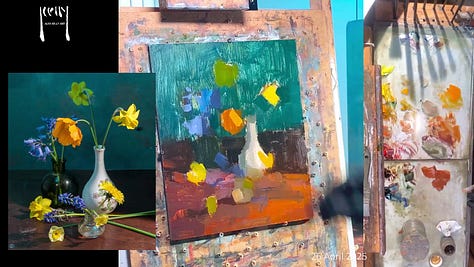Dear Subscribers,
The video above is the first part of the recording of the live painting class held on 26 April 2025. It includes my commentary, and a transcript is also provided — although it is autogenerated and may contain errors. Part two will be posted in the next newsletter.
Below are some screenshots showing various stages of the painting process during the class. The entire painting took approximately five hours to complete.









During the class, someone asked about how I use my medium. They were referring to a medium I had previously employed, which consisted of a mixture of one part stand oil to four or five parts odourless mineral spirits (OMS), with the addition of 1–2% cobalt drier. I am not currently using that particular medium, as I wanted to experiment with a commercially available medium that both accelerates drying and imparts a gloss to the paint film. It serves a broadly similar purpose to the medium I prepared myself but is noticeably thicker in consistency.
Additionally, I have reverted to using OMS to dilute the paint to a more 'inky' quality during the initial block-in stages, which I find easier to work with. Previously, I was not using any solvent such as OMS, but instead employed walnut oil to clean brushes, in conjunction with the homemade medium. This combination worked reasonably well, largely because the medium I made was significantly thinner than most shop-bought alternatives.
Another change over the past year concerns the type of surface I am working on. Formerly, I worked exclusively on oil-primed surfaces, which tend to be very slick and largely non-absorbent. I am now using acrylic-primed surfaces (without gesso content) that I subsequently seal with a thin coat of damar retouch varnish, which I prepare myself. This shift occurred out of necessity when I ran out of oil-primed panels during a workshop and was obliged to use an acrylic-primed surface. I discovered that it allowed for a more rapid build-up of paint layers, which is particularly useful for alla prima work.
However, this type of surface has disadvantages: it tends to stain easily and makes it more difficult to manipulate the paint. I mentioned during the class that this problem was compounded by the use of a thicker medium and the high ambient temperature in the studio, which caused the paint to tack up prematurely, inhibiting my ability to work the surface as I prefer. In hotter conditions, a thinner medium would clearly be advantageous, and I should bear this in mind for future sessions.
In conclusion, although all this discussion of mediums and surfaces might seem like a side issue to the principal challenges of painting, they are nonetheless important. One must remain adaptable and willing to experiment with different materials to find the most effective approach for the circumstances.
Subscribers can post questions to my substack chat here: Subscriber chat
The next live class will be on Saturday 24 May, starting at 5pm UK time. The link is at the very end of this email for paying subscribers.
The classes are typically about 3 hours long. Zoom login details are below, and you can join or leave at any time. If you can’t join for any reason or miss part of the session, I will be recording it and publishing via my newsletter and Substack afterwards. The classes are informal and an opportunity to chat about any aspects of painting that interest you.
I hope you find the recording interesting and look forward to seeing you in a future class!
Happy painting,
Alex













